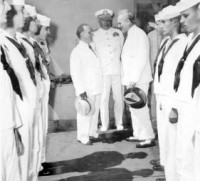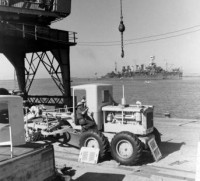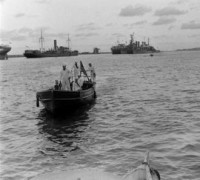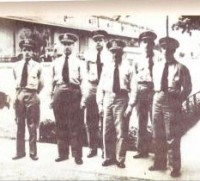MILITARY RELATIONS WITH BRAZIL BEFORE PEARL HARBOR - BRAZIL X USA MILITARY RELATIONS
6)GENERAL AMARO MISSION
After the tentative approval by both governments of a military staff agreement, General Amaro's mission was broadened to include the detailed negotiations that would be required to put the agreement into effect. His credentials, delivered to General Marshall in mid-December, stated that as soon as an understanding on the question of arms supply had been reached, he would become "Head of the Brazilian Military Committee" in the
General Amaro opened his formal conversations with American authorities on 8 January 1941. He first talked with Under Secretary of State Welles, who assured him that the Department of State would arrange for credits to finance the purchase of as much war material as the Army could release to
The Chief of Staff explained frankly that, while the Army would do all it could to help
The list of armaments presented by General Amaro was identical with that delivered to Colonel Miller the preceding June, except that Brazil now added to it the items that had been ordered from Germany but never delivered. War Department officers calculated that the expanded Brazilian requests would cost about $250,000,000, and they noted that Brazil wanted some items "in quantities in excess of the total amount available to United States forces and in at least one item, 37-mm. AP [armor-piercing] shell, in a quantity 50 percent greater than the combined total of United States and British requirements."
Obviously, they concluded, the Brazilian request would have to be reduced. General Amaro himself made a preliminary reduction by submitting a "first priority" listing, but this still amounted to nearly one half of the total.United States officers then worked out a tentative schedule specifying when the Brazilians could expect the items on the priority list to become available.
They divided it into three groups: (1) material that could be made available at once out of Army stocks--a few controlled mines and Waco primary training planes; (2) material that could be obtained in the near future if orders for it were placed immediately--other types of primary trainers and various items of military automotive equipment; and (3) material on which no deliveries could be made before November 1941 at the earliest--the great bulk of the items asked for, and all of the combat items.
The three lists were communicated to General Amaro on 15 January 1941, and on the next day he replied that Brazil now had a clear picture of what it could expect from the United States in the way of arms supply.Toward the end of January the Army proposed that a credit of $12,000,000 be made available to Brazil immediately to permit the procurement of the material in the first two groupings, as well as to finance the remaining expense for modernizing and making usable the coast defense guns sold to Brazil in 1940.
Working from the Brazilian first priority list, the Army also calculated an over-all schedule that would provide
The Department of State wanted to postpone the question of credits until the passage of the Lend-Lease Act, but was finally persuaded in March to arrange with the Export-Import Bank for the $12,000,000 credit initially recommended by the Army. The American-Brazilian arms negotiation during January and February 1941 had in effect cleared the air by letting the United States Army know what
But it had not produced a promise of early delivery of any modern combat equipment to
The current joint war plan (RAINBOW 4) called for the movement of a reinforced triangular division to
Work on the Brazilian airfields to be constructed or improved by Pan American was about to begin. But in addition to the work contracted for, the fields needed bomb and gasoline storage and other service facilities, and quarters for technicians and troop guards. The Navy also needed many new facilities at ports around the Brazilian bulge for its projected
The War Plans Division thought that what the Army ought to do in advance of any RAINBOW 4 situation, if it could, was to put small American troop units near the major airfields in order to insure against sudden and surprise seizure of them by Axis air forces. The
Solely from the military point of view, the Army would have much preferred that the
Initially, the American troops would teach Brazilian soldiers how to use the material, but afterward the Americans might be permitted to remain to help guard the airfields. In meetings on 3 January 1941, General Marshall discussed this proposal first with his staff and then with Admiral Stark and Under Secretary of State Welles. By that time the proposal involved placing one company of American soldiers at each of five airfield sites.
Both Mr. Welles and Admiral Stark approved the idea, and suggested that the Army take the matter up directly with General Amato. Late in January, having made some progress on the arms supply question, Colonels Ridgway and Miller (the latter having been summoned to
General Amaro doubted that
General Amaro's plan contemplated that after the training period the material would be turned over to the Brazilian Army and the American personnel would be returned to the
General Amaro, when shown this plan, urged a reduction in the number of personnel and insisted that the training center must be under Brazilian command. Since he also indicated rather clearly that he wanted a more definite commitment on arms supply before urging his government to accept any training center proposal, nothing further came of the project.Before Colonel Miller returned to
He insisted that the great majority of the Brazilians were "pro-American, pro-British, and anti-Axis." Nevertheless, they were highly nationalistic, jealous of their sovereignty, and opposed to any measure that could be interpreted as an infringement on Brazilian sovereignty. The Brazilians wanted to participate in hemisphere defense measures, not merely to acquiesce in them.
The
Colonel Miller cautioned against any attempt by the
The presence of only token American forces in
Internal differences of opinion among Brazilian civilian and military officials seem to have been primarily responsible for the failure of
It proposed to station permanently three of its five existing infantry divisions in
The War Plans Division in
This proposal prompted the American planners to suggest that American forces be sent to participate in the maneuvers. They proposed an American force, consisting of a composite air group, antiaircraft, signal, and engineer battalions, and some medical troops, to operate during the maneuvers under Brazilian command. After Mr. Welles approved the proposal, General Marshall asked Brig. Gen. Lehman W. Miller to sound out the Brazilians.
Transcribed by Patrick Clancey – Hyper War Foundation



